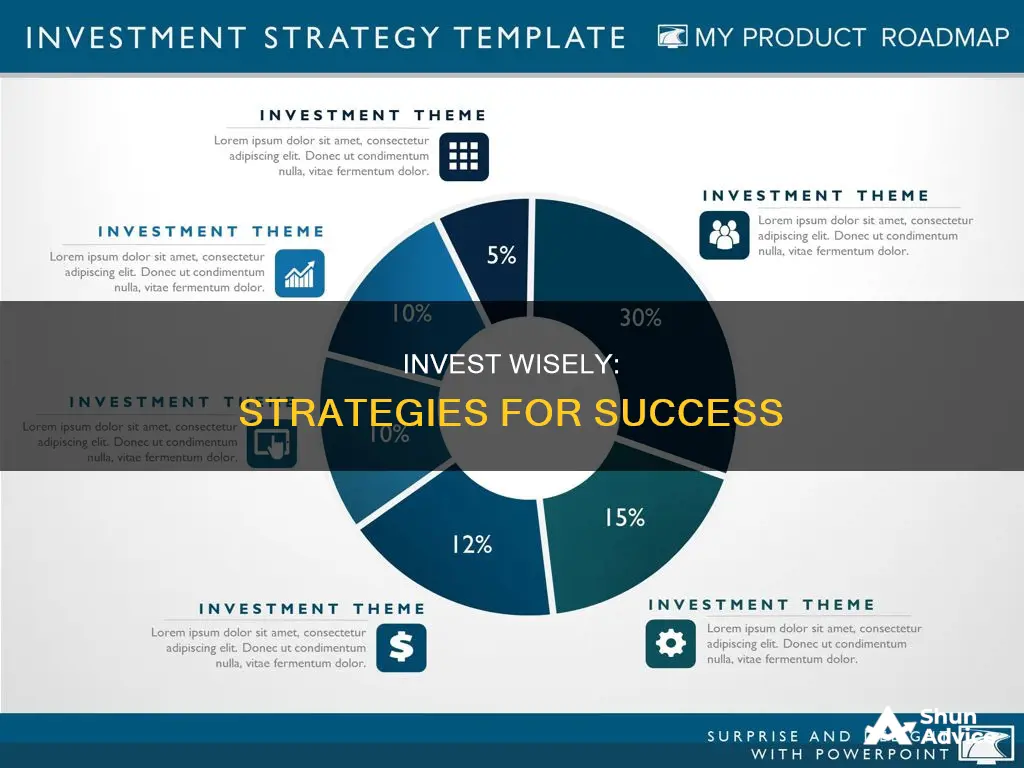
Making the right investments is a complicated decision that requires a thorough understanding of your financial situation, goals, and risk tolerance. It is essential to assess your immediate finances, including short-term debts and emergency funds, before considering long-term investments. Diversification is key to reducing risk, and investments should be chosen based on their alignment with your financial objectives, time horizon, and comfort with risk. While seeking advice from professionals and conducting research is beneficial, the final decision rests with the individual investor. It is crucial to remember that all investments carry some degree of risk, and higher-risk investments offer potentially higher returns but also come with a greater possibility of losses.
| Characteristics | Values |
|---|---|
| Risk tolerance | High, Medium, Low |
| Investment goals | Short-term, Long-term |
| Investment types | Stocks, Bonds, Mutual Funds, ETFs, LICs, Cash, Property, Alternative Investments |
| Investment costs | Brokerage fees, Mutual fund expense ratios, Management fees, Administration fees, Entry and Exit fees, Advisor charges |
| Investment time | Short-term (0-3 years), Long-term (5+ years) |
| Returns | 3-7% (Defensive), 3-4% (Fixed Interest), 6.3-6.5% (Growth), 6.6% (Stocks) |
| Diversification | Yes, No |
What You'll Learn

Evaluate your risk tolerance and financial goals
Evaluating your risk tolerance and financial goals is a crucial step in making the right investments. Here are some detailed instructions to help you through the process:
Understand Risk Tolerance:
Firstly, it's important to recognise that all investments carry some degree of risk. Risk tolerance refers to an investor's ability to handle market volatility and potential losses. It is influenced by factors such as time horizon, age, income, family circumstances, and personality. An aggressive investor with a high-risk tolerance is willing to risk losing money to achieve potentially better results, while a conservative investor with low-risk tolerance favours investments that maintain their original investment.
Assess Your Risk Profile:
To assess your risk tolerance, consider the following:
- Time Horizon: The longer you can wait before accessing your investments, the higher the risk you can typically take.
- Age: Younger investors generally have a longer time horizon and can tolerate more risk. However, older investors with substantial retirement funds may also have higher risk tolerance.
- Income: Those with higher and more stable incomes may have a greater tolerance for risk, as they can more easily absorb potential losses.
- Family Circumstances: Family obligations impact risk capacity. Those with partners and children may need more short-term emergency funds and savings for their children's education.
- Personality: Some individuals are naturally more cautious and risk-averse, while others are adventurous and willing to take on more risk.
Determine Your Financial Goals:
Understanding your financial goals is essential for making the right investments. Ask yourself:
- What are your short-term and long-term financial goals?
- Are you investing for a specific purpose, such as retirement, college savings, or a down payment on a home?
- How much money do you need to achieve these goals, and by when?
- Are you investing for capital gains, income generation, or a combination of both?
Match Risk Tolerance with Financial Goals:
Once you understand your risk tolerance and financial goals, you can match them appropriately:
- Short-Term Goals: If you're investing for a short-term goal, such as saving for a down payment on a home, you may have a lower risk tolerance. In this case, consider lower-risk investments like savings accounts, money market funds, or short-term bonds.
- Long-Term Goals: For long-term goals like retirement or college savings, you may have a higher risk tolerance. You can consider investing in stocks, mutual funds, or other higher-risk assets that have the potential for higher returns over the long term.
Regularly Reassess:
Remember that your risk tolerance and financial goals may change over time. Life events such as a change in career, retirement, health issues, or a sudden windfall can impact your risk tolerance. Regularly reassess your risk tolerance and adjust your investment strategies accordingly to ensure they remain aligned with your financial goals and comfort level.
By carefully evaluating your risk tolerance and financial goals, you can make more informed investment decisions that suit your needs and aspirations.
Americans: Investors or Not?
You may want to see also

Understand the different types of investments
There are three main investment categories: equity, fixed-income, and cash or cash equivalents.
Equity
Equity covers any kind of investment that gives the investor an ownership stake in an enterprise. This includes common stocks, preferred shares, funds that hold stocks (exchange-traded funds and mutual funds), private equity, and American depositary receipts.
Fixed-Income
Fixed-income covers any kind of investment where the investor loans money to an enterprise. The most common example is bonds, which can be corporate or government-issued. Some fixed-income securities have equity-like characteristics, such as convertible bonds.
Cash or Cash Equivalents
Cash and cash equivalents include physical cash, as well as checking accounts, savings accounts, money market accounts, and certificates of deposit. Money market funds are technically fixed-income securities, but they are sometimes considered cash equivalents because it's easy to withdraw money from these accounts.
Other Types of Investments
There are many other types of investments that fall outside of these three main categories. These include:
- Retirement plans, such as 401(k) plans, 403(b) plans, and individual retirement plans (IRAs)
- Options, which are contracts that give the investor the ability to buy or sell an asset at a certain price and time
- Annuities, which are insurance policies that provide periodic payments, often during retirement
- Derivatives, which are financial instruments that derive their value from another asset
- Commodities, which are physical products that can be invested in, such as metals, agricultural products, livestock, and energy resources
- Hybrid investments, which incorporate elements of equities and fixed-income securities, such as preferred shares and convertible bonds
C-Corp: Why Investors Choose This Structure
You may want to see also

Consider the time frame of your investments
When considering the time frame of your investments, it's important to understand the concept of an investment time horizon. This refers to the period of time one expects to hold an investment before needing the money back. Time horizons are dictated by investment goals and strategies, and they can vary from short-term (less than five years) to medium-term (three to ten years) and long-term (ten years or more).
The length of your time horizon will influence the type of investments you choose. Generally, the longer the time horizon, the more aggressive or riskier your portfolio can be, and vice versa. Here's how this might play out:
Short-Term Investment Horizon
Short-term investments are suitable for those approaching retirement or needing a large sum of cash in the near future. These investments are expected to last for fewer than five years. Money market funds, savings accounts, certificates of deposit, and short-term bonds are common choices for short-term investments as they can be easily liquidated for cash.
Medium-Term Investment Horizon
Medium-term investments are typically held for three to ten years and are often chosen by people saving for significant life events such as buying a home, marriage, or a child's education. Medium-term investment strategies usually balance high- and low-risk assets, so a mix of stocks and bonds can help protect your wealth while also guarding against inflation.
Long-Term Investment Horizon
Long-term investments are those held for ten or more years and are often associated with retirement savings. Long-term investors are generally willing to take greater risks in anticipation of greater rewards. With a longer time horizon, you can afford to be more aggressive in your asset allocation, as you have more time to recover from any short-term downturns.
It's worth noting that the longer the time horizon, the more the power of compounding comes into play. This means that even small investments made early on can generate high returns over several decades.
While timing your investments is important, it's even more crucial to focus on the time you stay invested rather than trying to predict market highs and lows. Historically, each downturn has been followed by an upswing, and the longer the time frame, the greater the chances of a positive outcome.
Fidelity Investments: Customer Feedback
You may want to see also

Diversify your portfolio
Diversifying your portfolio is a crucial aspect of investment strategy. It involves spreading your investments across various asset classes, sectors, and geographic regions to reduce risk and volatility while optimising returns. Here are some detailed insights on how to diversify your portfolio effectively:
Asset Allocation
Diversification starts with allocating your investments across different asset classes, such as stocks, bonds, cash, real estate, commodities, and alternative investments. A common strategy is to combine stocks and bonds, with stocks offering higher growth potential and bonds providing more stable income. For example, you could allocate 60% of your portfolio to stocks and 40% to bonds.
Sector and Industry Diversification
Within the stock portion of your portfolio, ensure you diversify across different sectors and industries. For instance, you could invest in technology, healthcare, finance, and consumer goods sectors. This diversification reduces the impact of any single sector's performance on your portfolio.
Geographic Diversification
Investing in companies from different countries and regions can further diversify your portfolio. Consider investing in both domestic and international stocks to minimise the risk of your portfolio being affected by country-specific or regional economic downturns.
Investment Vehicles
Utilise various investment vehicles to gain exposure to different markets and asset classes. Mutual funds, exchange-traded funds (ETFs), and index funds offer an easy way to diversify your portfolio. These funds typically hold a basket of securities or assets, providing instant diversification.
Regular Portfolio Review
Diversification is an ongoing process. Regularly review and rebalance your portfolio to ensure it aligns with your investment goals and risk tolerance. As your financial situation and market conditions change, adjust your portfolio accordingly to maintain the appropriate level of diversification.
Risk Management
When diversifying, always consider your risk tolerance. Some investments, like stocks, carry more risk than others, such as bonds or cash. Diversification helps manage risk, but it's essential to match your investment choices to your comfort level with risk.
Costs and Fees
Diversification can involve costs, such as transaction fees and management fees. Be mindful of these expenses, as they can impact your overall returns. Compare fees across different investment options to make informed choices.
In conclusion, diversifying your portfolio is a powerful strategy to balance risk and reward. It helps protect your investments from market fluctuations and specific risks associated with individual assets, sectors, or regions. By following these insights, you can effectively diversify your portfolio to achieve your financial goals.
Forging Checks: A Risky Investment Gamble
You may want to see also

Understand the fees and charges involved
Understanding the fees and charges involved is a crucial aspect of making the right investments. These fees can significantly impact your investment returns over time, so it's important to know what you're getting into. Here are some key points to consider:
Upfront Fees
Upfront fees are often charged when you initially purchase certain investments. For example, when buying shares through a platform or broker, you may encounter a transaction fee, as well as tax charges such as Stamp Duty (around 0.4%). When you eventually sell your shares, you'll typically need to pay another transaction fee. These transaction fees can add up, especially if you make frequent small trades, so it's generally advisable to hold onto your investments for the long term.
Ongoing Charges
Some investments, like buying into a fund, often involve ongoing management fees. These are regular charges, usually paid annually, for the continued management of your investment. Fees for more specialised funds, such as those actively investing in smaller companies, tend to be higher than those for more popular products. It's important to compare the fees charged by different providers to ensure you're getting the best deal.
Other Fees
In addition to upfront and ongoing fees, there are several other charges you may encounter:
- Platform fees: Charged by the platform or broker through which you make your investments.
- Management fees: Fees paid to the fund manager for managing your investments.
- Entry and exit fees: Charged when you enter or exit an investment, such as a managed fund or exchange-traded fund (ETF).
- Advisor charges: Fees paid for financial advice or advisory services.
Impact on Returns
Fees and charges can eat into your investment returns over time. For example, annual fees of 0.50% on a $100,000 investment over 20 years can reduce your portfolio's value by $10,000. Higher fees of 1% would reduce it by $30,000 over the same period. These fees also create opportunity costs by preventing your money from growing through compounding.
Lowering Fees
The good news is that many mutual fund companies and online brokers are lowering their fees to stay competitive. Take advantage of this trend by shopping around for the lowest costs. Additionally, keeping your investments for the long term and minimising frequent trades can help reduce the impact of transaction fees.
Investing: Hold or Fold?
You may want to see also
Frequently asked questions
Before investing, you should get your immediate finances in order. This means paying off any short-term debt, building an emergency fund, and investing more via your workplace pension. You should also be aware of your risk tolerance and financial goals.
You should understand what you are investing in. Research the company and its industry, and be aware of the risks involved. You should also consider the time frame of your investment and how hands-on you want to be.
All investments carry some degree of risk. Generally, the more risk you take, the higher the potential reward but also the higher the potential for losses. You should be aware of your risk tolerance and choose investments that match it.
Investment companies will charge for their services. There are two main types of fees: upfront fees, which you pay when you invest, and ongoing charges, which you pay regularly. You should also be aware of other fees such as platform fees, management fees, exit fees, and advisor charges.







